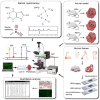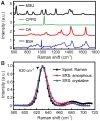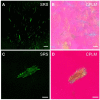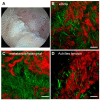Highly specific and label-free histological identification of microcrystals in fresh human gout tissues with stimulated Raman scattering
- PMID: 33537075
- PMCID: PMC7847673
- DOI: 10.7150/thno.53755
Highly specific and label-free histological identification of microcrystals in fresh human gout tissues with stimulated Raman scattering
Abstract
Gout is a common metabolic disease with growing burden, caused by monosodium urate (MSU) microcrystal deposition. In situ and chemical-specific histological identification of MSU is crucial in the diagnosis and management of gout, yet it remains inaccessible for current histological methods. Methods: Stimulated Raman scattering (SRS) microscopy was utilized to image MSU based on its fingerprint Raman spectra. We first tested SRS for the diagnosis capability of gout and the differentiation power from pseudogout with rat models of acute gout arthritis, calcium pyrophosphate deposition disease (CPDD) and comorbidity. Then, human synovial fluid and surgical specimens (n=120) were were imaged with SRS to obtain the histopathology of MSU and collagen fibers. Finally, quantitative SRS analysis was performed in gout tissue of different physiological phases (n=120) to correlate with traditional histopathology including H&E and immunohistochemistry staining. Results: We demonstrated that SRS is capable of early diagnosis of gout, rapid detection of MSU in synovial fluid and fresh unprocessed surgical tissues, and accurate differentiation of gout from pseudogout in various pathophysiological conditions. Furthermore, quantitative SRS analysis revealed the optical characteristics of MSU deposition at different pathophysiological stages, which were found to matched well with corresponding immunofluorescence histochemistry features. Conclusion: Our work demonstrated the potential of SRS microscopy for rapid intraoperative diagnosis of gout and may facilitate future fundamental researches of MSU-based diseases.
Keywords: gout; label-free histology; monosodium urate; stimulated Raman scattering.
© The author(s).
Conflict of interest statement
Competing Interests: The authors have declared that no competing interest exists.
Figures










Similar articles
-
Spatiotemporal Observation of Monosodium Urate Crystals Deposition in Synovial Organoids Using Label-Free Stimulated Raman Scattering.Research (Wash D C). 2024 May 27;7:0373. doi: 10.34133/research.0373. eCollection 2024. Research (Wash D C). 2024. PMID: 38803506 Free PMC article.
-
Osteoarthritis synovium as a nidus for monosodium urate crystal deposition inducing severe gout studied by label-free stimulated Raman scattering combined with synovial organoids.MedComm (2020). 2025 Jan 5;6(1):e70040. doi: 10.1002/mco2.70040. eCollection 2025 Jan. MedComm (2020). 2025. PMID: 39764563 Free PMC article.
-
Calcium pyrophosphate deposition disease: a frequent finding in patients with long-standing erosive gout.Scand J Rheumatol. 2018 Mar;47(2):127-130. doi: 10.1080/03009742.2017.1332239. Epub 2017 Aug 16. Scand J Rheumatol. 2018. PMID: 28812408
-
Clinical features of gout.Reumatismo. 2012 Jan 19;63(4):238-45. doi: 10.4081/reumatismo.2011.238. Reumatismo. 2012. PMID: 22303530 Review.
-
Synovial fluid analysis for crystals.Curr Opin Rheumatol. 2011 Mar;23(2):161-9. doi: 10.1097/BOR.0b013e328343e458. Curr Opin Rheumatol. 2011. PMID: 21285711 Review.
Cited by
-
Artificial Intelligence-Assisted Stimulated Raman Histology: New Frontiers in Vibrational Tissue Imaging.Cancers (Basel). 2024 Nov 22;16(23):3917. doi: 10.3390/cancers16233917. Cancers (Basel). 2024. PMID: 39682107 Free PMC article. Review.
-
An objective diagnosis of gout and calcium pyrophosphate deposition disease with machine learning of Raman spectra acquired in a point-of-care setting.Rheumatology (Oxford). 2025 Apr 1;64(4):1791-1798. doi: 10.1093/rheumatology/keae472. Rheumatology (Oxford). 2025. PMID: 39222431 Free PMC article.
-
Fiber-Enhanced Stimulated Raman Scattering and Sensitive Detection of Dilute Solutions.Biosensors (Basel). 2022 Apr 14;12(4):243. doi: 10.3390/bios12040243. Biosensors (Basel). 2022. PMID: 35448303 Free PMC article.
-
Spatiotemporal Observation of Monosodium Urate Crystals Deposition in Synovial Organoids Using Label-Free Stimulated Raman Scattering.Research (Wash D C). 2024 May 27;7:0373. doi: 10.34133/research.0373. eCollection 2024. Research (Wash D C). 2024. PMID: 38803506 Free PMC article.
-
Histological diagnosis of unprocessed breast core-needle biopsy via stimulated Raman scattering microscopy and multi-instance learning.Theranostics. 2023 Feb 21;13(4):1342-1354. doi: 10.7150/thno.81784. eCollection 2023. Theranostics. 2023. PMID: 36923541 Free PMC article.
References
-
- Kuo CF, Grainge MJ, Zhang W, Doherty M. Global epidemiology of gout: prevalence, incidence and risk factors. Nat Rev Rheumatol. 2015;11:649–62. - PubMed
-
- Zhu Y, Pandya BJ, Choi HK. Prevalence of gout and hyperuricemia in the US general population: The national health and nutrition examination survey 2007-2008. Arthritis Rheum. 2011;63:3136–41. - PubMed
-
- Dalbeth N, Merriman TR, Stamp LK. Gout. Lancet. 2016;388:2039–52. - PubMed
Publication types
MeSH terms
Substances
LinkOut - more resources
Full Text Sources
Other Literature Sources
Medical

